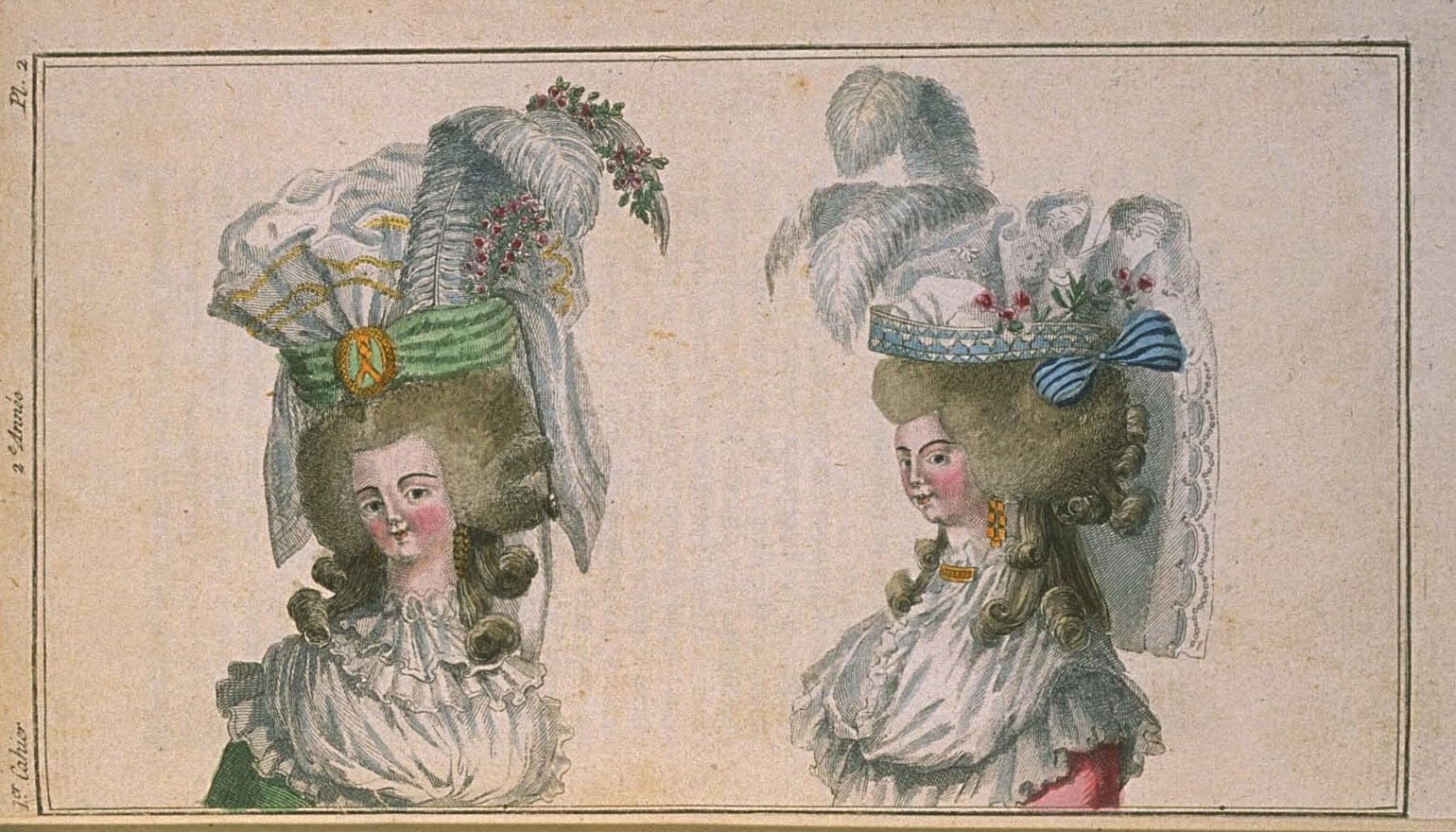Magasin des Modes, 1er Cahier, Planche II
 |
| November 20, 1786 |
These caps were born from the exquisite taste of the celebrated Actress (1) who played the role of Madame de Randan in The Loves of Bayard, a new Comedy by M. MONVEL. The sweet and tender air that they extended over her face, which she had been careful to render still calmer by the total lack of powder in her hair, and by a tint of melancholy, giving her this interesting air that allowed Madame de Randan to make the conquest of the sensitive King François I, of the brave Knight Bayard, of the generous de la Palice, of the presumptuous and galant Bonnivet, and even of the impudent and ferocious Sotomayor. The greater part of our Ladies who have adopted these coiffures were persuaded that they would make conquests as brilliant, or at least that they would have the seductive air of Mademoiselle Contat. Several, in effect, have succeeded. But, take guard: with these coiffures, one must have the most modest, the most decent, the most innocent, the most bounded, the most circumspect air: the least affectation would give a girlish air. Believe us, this candor, this amiable frankness, this truthful honesty of the good old days of Chivalry is required. It is because many Courtesans in the Capitol who have worn them lack these precious qualities or at least their appearances, that they have been booed at the Spectacles.
(1) Mademoiselle CONTAT, who had already created the caps à la Susanne, à la Figaro, etc.
Will they flatter themselves, these women, to produce the necessary illusion with their effrontery, and to recall the respectable Ladies of the Court of François I?
These caps à la Randan were only, originally as the Actress wore them, a type of turban, belted with a muslin or white batiste bandeau, embroidered with gold, and with a crown, also of muslin or white batiste, raised like a sugarloaf to almost a foot in height, wrapped with wide bands of batiste or muslin, decorated with gold fringe and trimmed with veils, which started at the top of the crown in the back and descended very low. Today these caps no longer form a sugarloaf: they puff out at the top. They have kept the bandeaux, which have varied, and in the middle of them is placed an escutcheon. They have kept the wide bands, trimmed with gold lace, but they have added plumes, artificial flowers, and gold tassels, falling on the left side.
The one worn by the Woman dressed in a gown of green satin is belted with an apple green taffeta bandeau, pleated in wide pleats. In the middle of the bandeau is embroidered a gold escutcheon. Above the bandeau are raised, by degrees, three large bands of white gauze, which wrap the base and which are decorated with gold lace; and above these bands, rising very high and to a certain width, is the base or puffed crown of the cap, of white gauze. To this base is attached a very long veil, which descends behind to below the hips. On the left, over the bandeau, is attached a gold cord, at the bottom of which hangs a gold tassel. On the same side, near the cord, three large white plumes are raised very high, and a bouquet of artificial roses, which are mixed with the plumes.
The Woman is frizzed only on the tapet, which is covered by the cap to two inches from the head. From the bottom of the tapet descend two large curls, which hang on the chest. Behind, her hair hangs à la Conseillère. All her hair is naturally colored, and has no powder at all.
She wears gold earrings à la Plaquette, and on her neck is an ample gauze kerchief, en chemise, with three collars.
The Woman dressed in a pink satin gown wears on her head a pouf à la Chinoise, of a form little different from the cap à la Turque shown in the previous Book. The bandeau is narrower. The base, composed of the same gauze, is wider, and much less raised. It is equally trimmed with plumes and artificial flowers. There is also, on the left side, a large bow of a ribbon of varied colors.
This Woman is frizzed on the tapet to the middle, and from the middle to the ends it is in very large curls, three of which hang floatingly on the chest. Her hair is pulled up in the back in a flat chignon.
She wears gold earrings à la Plaquette, and on her neck a full kerchief trimmed in two rows, and fastened in front with a gold pin whose head forms a large square, engraved with hieroglyphic characters.
A very elegantly-dressed Woman has appeared lately at the Spectacle, having her neck covered with a very large kerchief of muslin, with flowers of different colors, and with silk fringe on the edges. It was fastened in front with a long gold pin, whose head showed a very large monogram in diamond letters.



Comments
Post a Comment